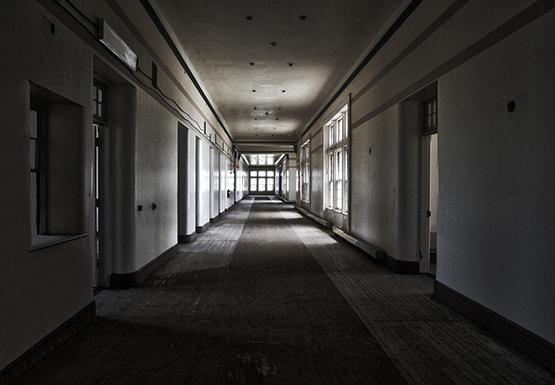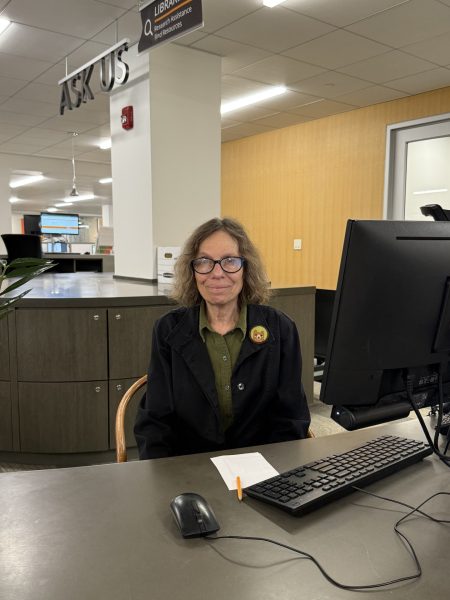Richardson, redux: Unveiling the mystery within the walls of an historic Buffalo landmark
The creepy, dilapidated building complex next door to Buffalo State has haunted me ever since I first saw it.
I’d just moved here, and we were driving down Elmwood, past the grounds of the old Buffalo State Asylum for the Insane (which has gone through a few name changes in its 143-year history). My very Christian aunt, who was driving, started spewing off about how evil the place was, how horrible, but I was immediately drawn to the majesty of the towers, the overall bleakness of the grounds back then. Something about it fascinated me, and since then I’ve always been intrigued. It wasn’t my reason for choosing Buffalo State to transfer to, but it was definitely a happy side effect, having it right next door.
At that point, I still had some illusions about the building. Some of them may still hold true today, after learning everything I’ve learned about its history. But nothing will ever change the feeling I got after walking into the former asylum for the very first time.
***
According to the July 1872 edition of the American Journal of Insanity, in 1869, a bill was passed by the New York State legislature to create an asylum in Western New York.
There were already a few in the state, but the closest one to Buffalo was in Utica and it was not cost effective to send patients all the way to central New York. So a committee of doctors got together and formulated a plan, fueled by a local movement led by then-Lieutenant Governor William Dorshimer.
In 1870, the act to establish the asylum in Buffalo passed, and the city granted the state 200 acres of unbroken land three miles from the city’s center.
That land has been chipped away at in the ensuing centuries, with 90 acres given back to create the school that is now this campus. Another corner of it is the current site of the Burchfield Penney Art Center. A good portion of it still stands, though, renovated with walkways and little mini-gardens in some corners. The building itself is still imposing, but up close in the daytime, I feel a little more at ease.
Monica Pellegrino Faix, the executive director of the Richardson Center Corporation, meets us at the door, and we chat for a bit about the grounds. She explains that the soil has been reused, and the pathways are the pieces of the old parking lot that was removed for the purposes of creating a facsimile of what the grounds had once been. There are also native plants and drainage gardens to reuse water, creating an environmentally friendly design.
Frederick Law Olmsted and Calvert Vaux collaborated with Henry Hobson Richardson (from whom the complex gets its name) on the landscaping and siting of the buildings.
Richardson’s vision for the asylum was based on the Kirkbride Plan, named for Dr. Thomas Kirkbride, who believed in a “humane treatment environment.” The more light, ventilation, privacy and “homelike” atmosphere there was, the better the recovery for the patient.
This is why, as Pellegrino Faix points out later on, the buildings also sit at a bit of an angle toward Forest Avenue — more sunlight and more air.
I’d never realized this, which is why it’s a slight shock to me that it’s so bright as we walk through the Towers building, then the wards. For some reason, I’d always imagined the inside of this place to be something out of American Horror Story, but there’s very little doom and gloom that I can see. My perceptions have already been altered with just a few steps inward.
***
The entrance of the Towers building, used mainly for administrative purposes, has been almost completely finished. A large wooden staircase to the left leads you to the upper floors, and Pellegrino Faix points out that the staircase was originally in the middle, but was moved when overcrowding forced patients into the upper floors.
Everything in the buildings is fairly simple — big, plain doors, not a lot of ornate woodwork. Richardson had a unique style to his buildings, coined “Richardsonian Romanesque,” but apparently this building didn’t quite qualify as that style.
“This was early in Richardson’s career, so it wasn’t considered that style just yet,” Pellegrino Faix says, comparing the asylum to other buildings he designed, such as the New York State Capitol and City Hall in Albany. “But there was still a lot of heavy stone, rough edges, little ornament. Arches are another one of his elements.”
The main building and two of the eastern wards — the male wards — were constructed of Medina sandstone. Richardson had intended for all of the buildings to be this stone, but a recession in the late 1800s forced him to construct the rest of the male wards with red brick. This was mirrored with the western female wards once the recession ended. The Richardson Center Corporation has plans to make the wards into hotel rooms.
A narrow, curved hallway — curved to discourage the placing of beds in the halls — leads you to the wards themselves, which consist of wide white hallways flanked by tiny rooms on either side, for the patients to sleep in. The entire hallway is bright with sunlight.
“This was meant to be a place where you could leave your troubles behind for a bit, and you would get better,” Pellegrino Faix had said earlier, and in that cavernous hall I can almost see how that would be true. But the tiny rooms and signs of decay remind me that this is still a place far removed from that goal.
I take in everything that I can in the buildings: the high ceilings, the superintendent’s office — a room so large that the fireplace on the left is almost dwarfed by the sheer amount of white wall — and the tile of the first hallway, a surprisingly complex pattern of orange, red and blue.
“This was probably the nicest hallway — they would take patients’ families into this ward first, to show them that this was a nice facility,” Pellegrino Faix mentions. Not exactly encouraging, but I let it go as we move to the next location.
Perhaps the biggest surprise was on the Towers building’s third floor.
We climb an exhaustingly long, steep and narrow spiral staircase to the top, turn into a hallway and find ourselves in an enormous blue room. A light blue cross is haphazardly painted on one of the walls, and sun pours in over exposed brick on another. This was the chapel, Pellegrino Faix says, and as she explains how there are plans to use it as a conference space, I keep glancing at the cross, wondering whose brush had put it there.
***
Pellegrino Faix doesn’t touch on the more complex aspects of the asylum’s history, namely the perception (or misconception, perhaps) of it being haunted, fueled by the misguided practices by doctors on the mentally ill over the decades — lobotomies and shock treatment, for example. Of course, as medicine and technology got more sophisticated, these treatments lost popularity, but that doesn’t change some people’s ideas of the number of deaths within the asylum’s walls. And in my research, I’ve found only one reported case of abuse – in 1881, when the New York Times reported that attendant Frank P. Churchill had accused two other attendants, Robert Jones and J.F. McMichael, of habitually maltreated patients.
“We will not pursue ghost hunting, horror films, or paranormal endeavors,” Pellegrino Faix says firmly as we walk through the first male ward. “We want people to experience the authentic story, and respect what this was.”
That means no haunted talk.
However, she does mention that one of the day rooms was used for a scene in the Robert Redford film “The Natural,” which I had never known.
Aside from accuracy, protection is a major concern for the Richardson Center Corporation.
“A lot of our money is put toward reducing break-ins,” Pellegrino Faix says. “A lot of them happen especially around this time (Halloween), and a lot of them are college kids. So we really just want to discourage that.”
Indeed, much of the focus during this tour has been on the positive, including Richardson’s master plan to create this former state-of-the-art complex in the first place. That’s surely by design, but at the same time I can see the reasons they want to set the record straight. Though not every ideal was achieved, the intent was there – the work of people just trying to make a difference in the lives of those who couldn’t do that for themselves. And now this corporation is trying to carry out the rest, in a different way.
“It’s amazing how many people love this building, and want to ensure that it’s saved,” Pellegrino Faix says. Count me among them.
Email: [email protected]
Twitter: @A_Rodriguez39











Kate Cocco • Sep 17, 2014 at 5:35 pm
I enjoyed your article because my great-grandfather, James T. Stines, was committed to this asylum in 1907. He lost his wife and newborn that year, then ran away from his job as a postal clerk to go on a despondent bender. He had taken his mailbag and keys, so he had broken federal law. In Oct of 1907, he pled insanity and was committed. I know he died soon thereafter, but cannot find out the year.
I wish I could find medical records from that institution.